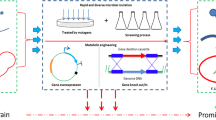Abstract
Objective
To study the ability of a commercial Penicillium camemberti strain, used for Camembert type cheese ripening, to produce conidia during growth in liquid culture (LC), in media containing different sources of nitrogen as, industrially, conidia are produced by growth at the surface of a solid state culture because conidiation in stirred submerged aerobic LC is not known.
Results
In complex media containing peptic digest of meat, hyphae ends did not differentiate into phialides and conidia. Contrarily, in a synthetic media containing KNO3 as sole nitrogen source, hyphae ends differentiated into phialides producing 0.5 × 107 conidia/ml. Conidia produced in LC were 25 % less hydrophobic than conidia produced in solid culture, and this correlates with a seven-times-lower expression of the gene rodA encoding hydrophobin RodA in the mycelium grown in LC.
Conclusion
Conidiation of P. camembertii is stimulated in iquid medium containing KNO3 as sole source of nitrogen and therefore opens up opportunities for using liquid medium in commercial productions.



Similar content being viewed by others
References
Aimanianda V, Bayry J, Bozza S, Kniemeyer O, Perruccio K, Elluru SR, Clavaud C, Paris S, Brakhage AA, Kaveri SV, Romani L, Latgé JP (2009) Surface hydrophobin prevents immune recognition of airborne fungal spores. Nature 27:1117–1121
Andrianopoulos A, Timberlake WE (1994) The Aspergillus nidulans abaA genes encodes a transcriptional activator that acts as a genetic switch to control development. Mol Cell Biol 14:2503–2515
Bockelmann W, Portious S, Lick S, Heller KJ (1999) Sporulation of Penicillium camemberti in submerged batch culture. Syst Appl Microbiol 22:479–485
Boualem K, Waché Y, Garmyn D, Karbowiak T, Durand A, Gervais P, Cavin JF (2008) Cloning and expression of genes involved in conidiation and surface properties of Penicillium camemberti grown in liquid and solid cultures. Res Microbiol 159:110–117
Boualem K, Gervais P, Cavin JF, Waché Y (2014) Production of conidia of Penicillium camemberti in liquid medium through microcycles of conidiation. Biotechnol Lett 36:2239–2243
Garcia-Ortiz N, Tlecuitl-Beristain S, Favela-Torres E, Loera O (2015) Production and quality of conidia by Metarhizium anisopliae var. lepidiotum: critical oxygen level and period of mycelium competence. Appl Microbiol Biotechnol 99:2783–2791
Krasniewski I, Molimard P, Feron G, Vergoignan C, Durand A, Cavin JF, Cotton P (2006) Impact of solid medium composition on the conidiation in Penicillium camemberti. Process Biochem 41:1318–1324
Latgé JP, Bouziane H, Diaquin M (1988) Ultrastructure and composition of the conidial wall of Cladosporium cladosporioides. Can J Microbiol 34:1325–1329
Lee BN, Adams TH (1994) The Aspergillus nidulans fluG gene is required for production of an extracellular developmental signal. Genes Dev 8:641–651
Mirabito PM, Adams TH, Timberlake WE (1989) Interactions of three sequentially expressed genes control temporal and spatial specificity in Aspergillus development. Cell 57:859–868
Morton AG, England DJF, Towler DA (1958) The physiology of sporulation in Penicillium griseofulvum Dierckx. Trans. Brit. Soc 1:39–51
Paris S, Debeaupuis JP, Crameri R, Carey M, Charlès F, Prévost MC, Schmitt C, Philippe B, Latgé JP (2003) Conidial hydrophobins of Aspergillus fumigatus. Appl Environ Microbiol 69:1581–1588
Pascual P, Melgarejo S, Magan N (1997) Induction of submerged conidiation of the biocontrol agent Penicillium oxalicum. Appl Microbiol Biotechnol 48:389–392
Roncal T, Cordobés S, Sterner O, Ugalde U (2002) Conidiation in Penicillium cyclopium is induced by conidiogenone, an endogenous diterpene. Eukaryot Cell 1:823–829
Smits THM, Wick LY, Harms H, Keel C (2003) Characterization of the surface hydrophobicity of filamentous fungi. Environ Microbiol 5:85–91
Tudzynski B (2014) Nitrogen regulation of fungal secondary metabolism in fungi Front Microbiol 5:656
Ugalde UO, Pitt D (1983) Silicone coating to prevent accretion on glass walls by Penicillium cyclopium grown in shaken flask culture. Trans Br Mycol Soc 81:412–415
Wessels JGH, De Vries OMH, Asgeirsdottir SA, Schuren FHJ (1991) Hydrophobin genes involved in formation of aerial hyphae and fruit bodies in Schizophyllum. Plant Cell 3:793–799
Wösten HAB (2001) Hydrophobins: multipurpose proteins. Ann. Rev Microbiol 55:625–646
Wösten HAB, De Vocht ML (2000) Hydrophobins, the fungal coat unravelled. Biochim Biophys Acta 1469:79–86
Acknowledgments
K. Boualem was supported by PhD Franco-Algerian grant and by the CROUS of Dijon, France. This study was supported by the French Minister of Education and Research, the Conseil Régional de Bourgogne, and INRA. We are very grateful to Christine Rojas and Catherine Viel for laboratory work.
Supporting information
Supplementary Table 1—Primers used.
Author information
Authors and Affiliations
Corresponding author
Electronic supplementary material
Below is the link to the electronic supplementary material.
Rights and permissions
About this article
Cite this article
Boualem, K., Labrie, S., Gervais, P. et al. Conidiation of Penicillium camemberti in submerged liquid cultures is dependent on the nitrogen source. Biotechnol Lett 38, 329–335 (2016). https://doi.org/10.1007/s10529-015-1983-1
Received:
Accepted:
Published:
Issue Date:
DOI: https://doi.org/10.1007/s10529-015-1983-1




